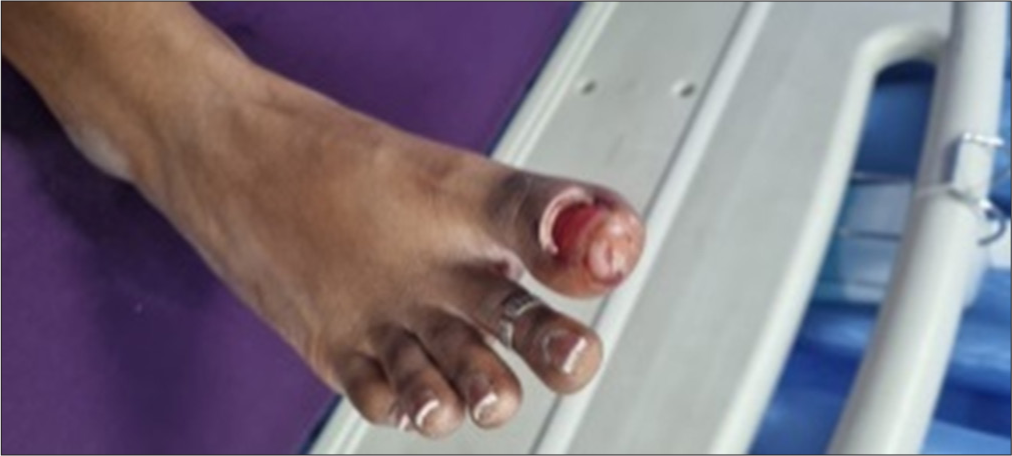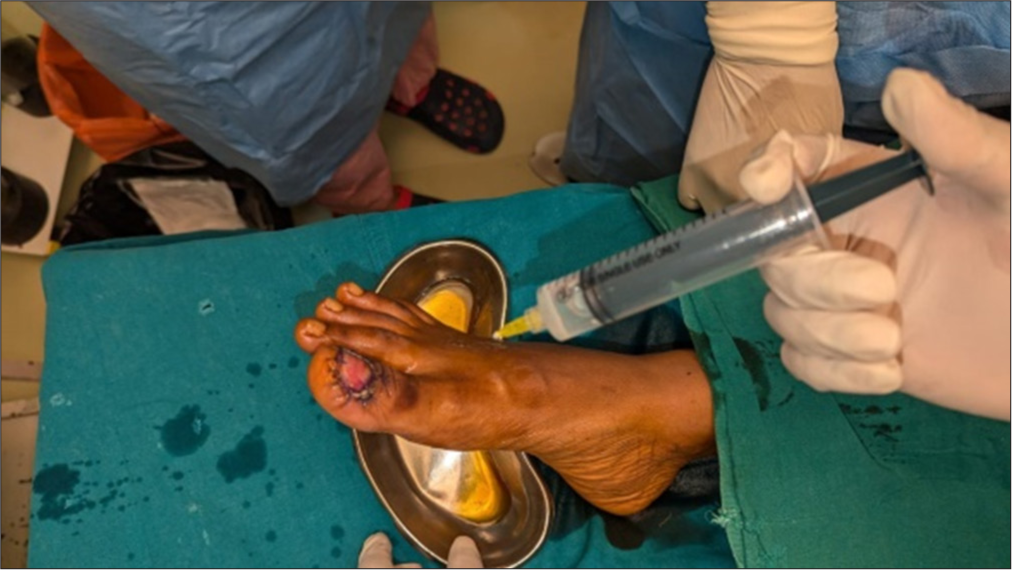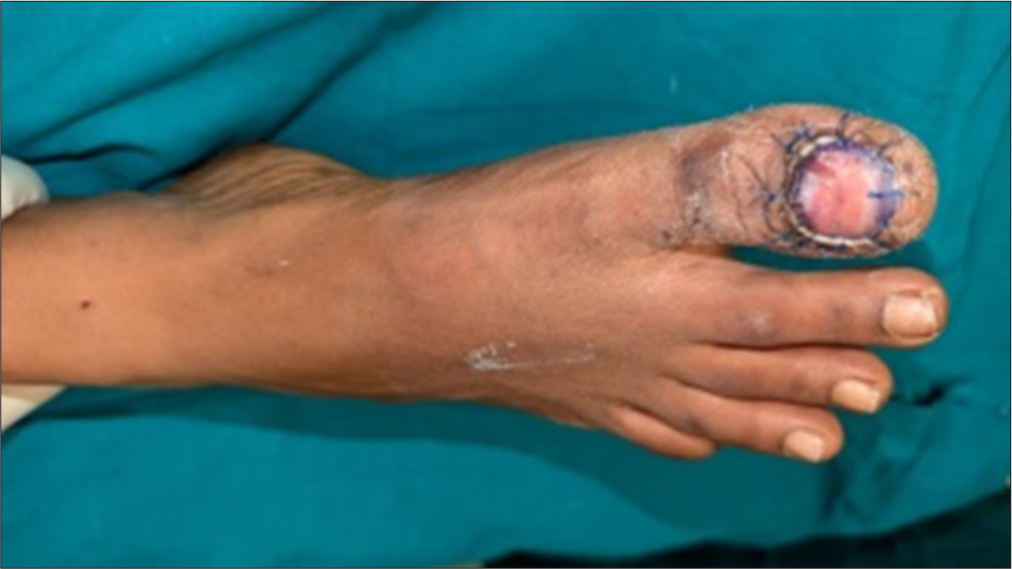Translate this page into:
Use of biodegradable temporizing matrix for traumatic avulsion of toenail for preparing its bed

*Corresponding author: Ravi Kumar Chittoria, Department of Plastic Surgery, Jawaharlal Institute of Postgraduate Medical Education and Research, Puducherry, India. drchittoria@yahoo.com
-
Received: ,
Accepted: ,
How to cite this article: Chittoria RK, Reddy BRJ. Use of biodegradable temporizing matrix for traumatic avulsion of toenail for preparing its bed. CosmoDerma. 2025;5:9. doi: 10.25259/CSDM_190_2024
Abstract
Fingernails have an important role in hand function. They protect the dorsal surface of the distal phalanges of the fingers and increase the sensitivity of the fingertip. The fingernails facilitate the pinch of small objects, allow scratching, and have a fundamental cosmetic role. There are so many treatment options for treatment of nail avulsion such as grafting, nail transplantation, and dermal graft. The aim of this case report is to assess the role of in management of Biodegradable Temporizing Matrix (BTM) in traumatic nail avulsion injury. Clinical examination of the nail injury before and after the use of BTM was done.
Keywords
Biodegradable temporizing matrix
Traumatic avulsion
Wound bed
Toenail avulsion
INTRODUCTION
The NovoSorb® Biodegradable Temporizing Matrix (BTM) (PolyNovo Biomaterials Pty Ltd., Port Melbourne, VIC, Australia) is a fully synthetic dermal matrix that can be used to reconstruct complex wounds. It consists of a 2-mm thick NovoSorb biodegradable polyurethane open-cell foam covered by a non-biodegradable sealing membrane. The open cell matrix allows for infiltration of cellular materials and acts as a scaffold for the neo-dermis. The sealing membrane provides physiological wound closure but also contains small fenestrations to prevent the accumulation underneath the material.[1] The application of BTM involves a two-stage procedure.[1] In the first stage, the BTM is laid onto a clean wound bed. Cells and blood vessels migrate into the BTM during the integration phase and a vascularized neo-dermis is formed. Capillary refill can be seen from as early as two weeks. The polyurethane matrix is biodegradable and breaks down through hydrolysis.[2] In the second stage, the sealing membrane is removed and a split-skin graft (SSG) is applied to the neo-dermis.[2] BTM differs from the traditional SSG in that it helps to replace the natural thickness of the dermis, minimizes contracture, prevents tethering to the underlying structures, and allows for the rapid temporizing of large total body surface area wounds.[3] Unlike other artificial dermal templates that are comprised of allogenic or xenogenic materials, the fully synthetic BTM eliminates the possibility of inter-species immune rejection or disease transmission and avoids ethical or cultural obstacles.[4] Early in vitro studies confirmed the biocompatibility of BTM.[2,5] In vivo studies utilizing rats and porcine models demonstrated adequate reconstruction of full-thickness wounds with a high resistance to wound contracture and an absence of systemic toxic effects.[6,7] Comparisons between BTM and Integra® (Life Sciences Corp., Plainsboro, NJ, USA) in animal models highlighted the effectiveness of the BTM in providing stable and flexible wound reconstruction.[4,8] The first use in humans was trialed as polyurethane foam (NovoPore™, Polynovo) in negative-pressure wound therapy (NPWT) for pressure ulcers.[9] This showed that short-term implantation in patients did not cause adverse reactions. Following this, the use of a prototype bilayer device consisting of NovoSorb foam with a non-biodegradable sealing matrix in free flap donor ulcers showed promising results.[10] Further modification of the sealing membrane including the thickness, bonding layer, and the introduction of fenestrations produced superior results in subsequent studies.[11] The use of BTM in burns demonstrated that it could successfully treat Sacral pressure injuries with excellent cosmetic and functional results.[3,12] This success led to its use in necrotizing soft-tissue infections to provide pliable wound coverage.[13,14] Here, we report a case of nail avulsion describing the use of BTM, which would otherwise require more complex reconstructions.
CASE REPORT
A 27-year-old female attended Jawaharlal Institute of Postgraduate Medical Education and Research (JIPMER) Hospital, post injury to the right great toe while climbing stairs. The patient was admitted to JIPMER under Plastic Surgery as traumatic avulsion of the right great toenail plate [Figure 1]. She underwent wound debridement, regular cleaning, and dressing. She was planned and underwent hydro-jet therapy + Silverstein irrigation + collagen and silicon scaffold (BTM) + Clinical negative pressure wound therapy (CRNPWT) [Figures 2 and 3]. The first stage of reconstruction involved the application of BTM. After the application of BTM, NPWT was applied over the BTM and secured with pressure between 50 and 75 mmHg or dressed with gauze, and crepe to provide compression. The external dressing was changed once or twice weekly. The BTM was evaluated weekly for integration by assessing for capillary refill. Excess fluid was expressed through the fenestrations before re-dressing.

- Right great toe nail plate wound in 27-year-old female.

- Biodegradable temporizing matrix application over the right great toe nail plate avulsion wound.

- Silverstein irrigation therapy placed over the wound.
The wound bed was not completely ready for the second stage, which is the reconstruction of the wound; hence, the first stage was planned to be continued till the wound bed was ready.
BTM helped in wound bed preparation of the nail avulsion wound in the patient, thus helping in early recovery [Figure 4].

- Improved right great toe nail bed wound after biodegradable temporizing matrix.
DISCUSSION
BTM has demonstrated its reliability and versatility in the reconstruction of complex wounds in a patient by converting the need for a flap c over t o t he n eed f or j ust s plit-thickness graft. Most cases were successfully grafted an d at 3–4 weeks post-operatively initiation of growth of physiological nail tissue and optimal complete result can be expected at around 12–18 months postoperatively. Furthermore, the dermal matrix was robust enough to heal in the setting of partial graft loss. Advantages of BTM include the ability to convert a wound bed into a surface suitable for skin graft, such as an exposed nail bed. In the case of exposed nail bed post avulsion, this also allows earlier recovery of nail growth. In patients with multiple morbidities, it provides a robust and simple reconstructive option for complex wounds.[3] The operation can be performed under local or regional anesthesia and has an overall low complication profile and donor-site morbidity.[9] The sensory regeneration of the wounds reconstructed with BTM can significantly influence the patient’s quality of life after the reconstruction. This is particularly important when BTM is used in the weight-bearing portion of the lower limb. A sensate reconstruction can maintain function and also help in preventing further injury to the area.[10,11]
In our case, early results are promising, with the patient regaining partial sensation over the majority of her wounds. This may provide further benefits o v er m o re c o mplex reconstructions. Further studies with longer follow-ups and more in-depth sensory assessment would be beneficial.
Disadvantages of BTM include potential failure to integrate, especially in cases of borderline vascularity or infection, as well as the staged nature of the reconstruction. These limitations are, however, common to all dermal matrices. This may form the basis of future studies.
CONCLUSION
BTM is an effective measure for enhancing the wound bed preparation of traumatic nail avulsion injury wounds. Limitations were that it was done on a single patient and here BTM and NPWT were used together. Isolated use of BTM is needed to form the basis of BTM applicability.
Authors’ contributions
RKC: Content, design, corrections. BPR: Content, alignment.
Ethical approval
The Institutional Review Board has waived the ethical approval for this study.
Declaration of patient consent
The authors certify that they have obtained all appropriate patient consent.
Conflicts of interest
There are no conflicts of interest.
Use of artificial intelligence (AI)-assisted technology for manuscript preparation
The authors confirm that there was no use of artificial intelligence (AI)-assisted technology for assisting in the writing or editing of the manuscript and no images were manipulated using AI.
Financial support and sponsorship
Nil.
References
- The evolution of acute burn care-retiring the split skin graft. Ann R Coll Surg Engl. 2017;99:432-8.
- [CrossRef] [PubMed] [Google Scholar]
- Evaluation of NovoSorb novel biodegradable polymer for the generation of a dermal matrix part 1: In-vitro studies. Wound Pract Res. 2010;18:14.
- [Google Scholar]
- Experience with a synthetic bilayer biodegradable temporizing matrix in significant burn injury. Burns Open. 2018;2:17-34.
- [CrossRef] [Google Scholar]
- Artificial dermal templates: A comparative study of NovoSorb Biodegradable Tempo-rising Matrix (BTM) and Integra(R) Dermal Regeneration Template (DRT) Burns. 2016;42:1088-96.
- [CrossRef] [PubMed] [Google Scholar]
- Evaluation of a novel biodegradable polymer for the generation of a dermal matrix. J Burn Care Res. 2009;30:717-28.
- [CrossRef] [PubMed] [Google Scholar]
- Evaluation of NovoSorb novel biodegradable polymer for the generation of a dermal matrix part 2: In-vivo studies. Wound Pract Res. 2010;18:24.
- [Google Scholar]
- Optimization of a polyurethane dermal matrix and experience with a polymer-based cultured composite skin. J Burn Care Res. 2014;35:437-48.
- [CrossRef] [PubMed] [Google Scholar]
- Comparison of a sealed, polymer foam biodegradable temporizing matrix against Integra(R) dermal regeneration template in a porcine wound model. J Burn Care Res. 2012;33:163-73.
- [CrossRef] [PubMed] [Google Scholar]
- A randomized, controlled trial of negative pressure wound therapy of pressure ulcers via a novel polyurethane foam. Wound Repair Regen. 2014;22:205-11.
- [CrossRef] [PubMed] [Google Scholar]
- A biodegradable polyurethane dermal matrix in reconstruction of free flap donor sites: A pilot study. Eplasty. 2015;15:e13.
- [Google Scholar]
- Free flap donor site reconstruction: A prospective case series using an optimized poly-urethane biodegradable temporizing matrix. Eplasty. 2015;15:e27.
- [Google Scholar]
- Reconstruction of extensive calvarial exposure after major burn injury in 2 stages using a biodegradable polyurethane matrix. Eplasty. 2016;16:e17.
- [Google Scholar]
- Biodegradable temporizing matrix (BTM) for the reconstruction of defects following serial debridement for necrotising fasciitis: A case series. Burns Open. 2019;3:12-30.
- [CrossRef] [Google Scholar]
- Biodegradable temporizing matrix for necrotising soft tissue infections: A case report. Aust J Plast Surg. 2019;2:106-9.
- [CrossRef] [Google Scholar]







